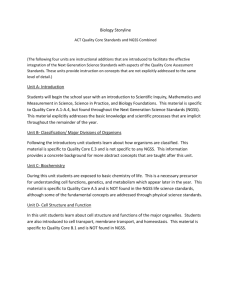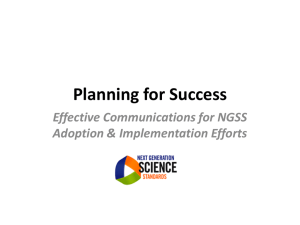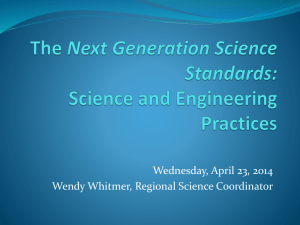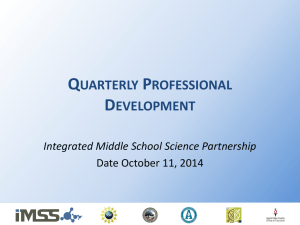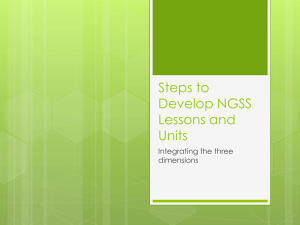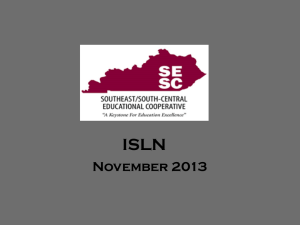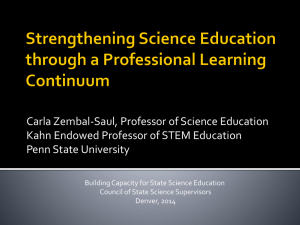Next Generation Science Standars Attachment State Level Timeline
advertisement
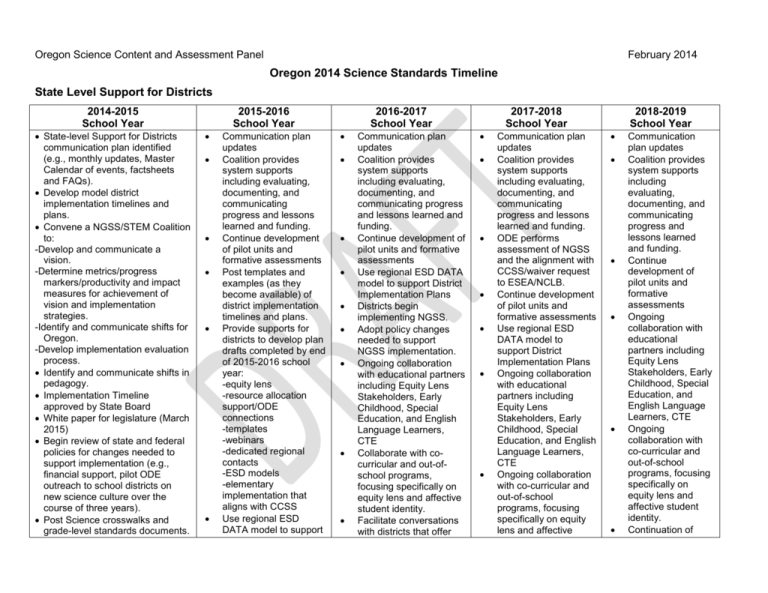
Oregon Science Content and Assessment Panel February 2014 Oregon 2014 Science Standards Timeline State Level Support for Districts 2014-2015 School Year State-level Support for Districts communication plan identified (e.g., monthly updates, Master Calendar of events, factsheets and FAQs). Develop model district implementation timelines and plans. Convene a NGSS/STEM Coalition to: -Develop and communicate a vision. -Determine metrics/progress markers/productivity and impact measures for achievement of vision and implementation strategies. -Identify and communicate shifts for Oregon. -Develop implementation evaluation process. Identify and communicate shifts in pedagogy. Implementation Timeline approved by State Board White paper for legislature (March 2015) Begin review of state and federal policies for changes needed to support implementation (e.g., financial support, pilot ODE outreach to school districts on new science culture over the course of three years). Post Science crosswalks and grade-level standards documents. 2015-2016 School Year Communication plan updates Coalition provides system supports including evaluating, documenting, and communicating progress and lessons learned and funding. Continue development of pilot units and formative assessments Post templates and examples (as they become available) of district implementation timelines and plans. Provide supports for districts to develop plan drafts completed by end of 2015-2016 school year: -equity lens -resource allocation support/ODE connections -templates -webinars -dedicated regional contacts -ESD models -elementary implementation that aligns with CCSS Use regional ESD DATA model to support 2016-2017 School Year Communication plan updates Coalition provides system supports including evaluating, documenting, and communicating progress and lessons learned and funding. Continue development of pilot units and formative assessments Use regional ESD DATA model to support District Implementation Plans Districts begin implementing NGSS. Adopt policy changes needed to support NGSS implementation. Ongoing collaboration with educational partners including Equity Lens Stakeholders, Early Childhood, Special Education, and English Language Learners, CTE Collaborate with cocurricular and out-ofschool programs, focusing specifically on equity lens and affective student identity. Facilitate conversations with districts that offer 2017-2018 School Year Communication plan updates Coalition provides system supports including evaluating, documenting, and communicating progress and lessons learned and funding. ODE performs assessment of NGSS and the alignment with CCSS/waiver request to ESEA/NCLB. Continue development of pilot units and formative assessments Use regional ESD DATA model to support District Implementation Plans Ongoing collaboration with educational partners including Equity Lens Stakeholders, Early Childhood, Special Education, and English Language Learners, CTE Ongoing collaboration with co-curricular and out-of-school programs, focusing specifically on equity lens and affective 2018-2019 School Year Communication plan updates Coalition provides system supports including evaluating, documenting, and communicating progress and lessons learned and funding. Continue development of pilot units and formative assessments Ongoing collaboration with educational partners including Equity Lens Stakeholders, Early Childhood, Special Education, and English Language Learners, CTE Ongoing collaboration with co-curricular and out-of-school programs, focusing specifically on equity lens and affective student identity. Continuation of Form partnerships with other NGSS-adopting states. Identify resources from CCSSO, NWRCC, Achieve, NSTA, and other states (e.g., assessment tasks, EQuIP NGSS Rubric, and other documents as shown on Achieve “Upcoming Resources” document). Collaborate with NGSS-adopting states to share resources and best practices. Collaborate with OEA, OUS, CCWD, OSTA, educational research partners, STEM hubs, ESDs, business/industry partners, and informal community partners to develop pilot units and formative assessments. Collaborate with TSPC and OEA to address endorsements, workload, and other issues that may arise. Utilize private sector/foundations/ research institutions/ other state agency supports for initial funding. Provide “General Awareness” presentations, including: structure, instructional shifts, equity lens, and assessment. Identify funding sources and grant-writing professional development. Identify regional advocates to serve as points of contact for districts. Connect with Professional Learning Teams’ work to facilitate rollout. District Implementation Plans Establish criteria for vetting, evaluating, and adopting interim materials that support NGSS (e.g., EQuIP, Publishers Criteria). Propose policy changes needed to support NGSS implementation. Ongoing collaboration with educational partners including Equity Lens Stakeholders, Early Childhood, Special Education, and English Language Learners. Develop/Coordinate/ Select of an effective ODE portal system of resources considering the following criteria: -format -criteria -support -review -promotion -incentives (for submission/use of resources) Conduct webinars to train district teams and ODE staff to use NGSS resources. Provide presentations at statewide events (e.g., COSA, OSTA, OSBA). GEDs for appropriate alignment. Update adoption policies for curriculum materials, including traditional textbooks and digital resources (including OERs) that are aligned to the three dimensions. Implement ODE portal system of resources considering the following criteria: -format -criteria -support -review -promotion -incentives (for submission/use of resources) Conduct trainings for the Oregon Legislature student identity. Post ESD/STEM Hub/district-created implementation resources. Ongoing collaboration and communication of internal educational enterprise and external informal educational stakeholders (e.g., Native Americans and intergenerational wisdom pertaining to other cultural groups). Continuation of adoption process for NGSS instructional materials. adoption process for NGSS instructional materials.


